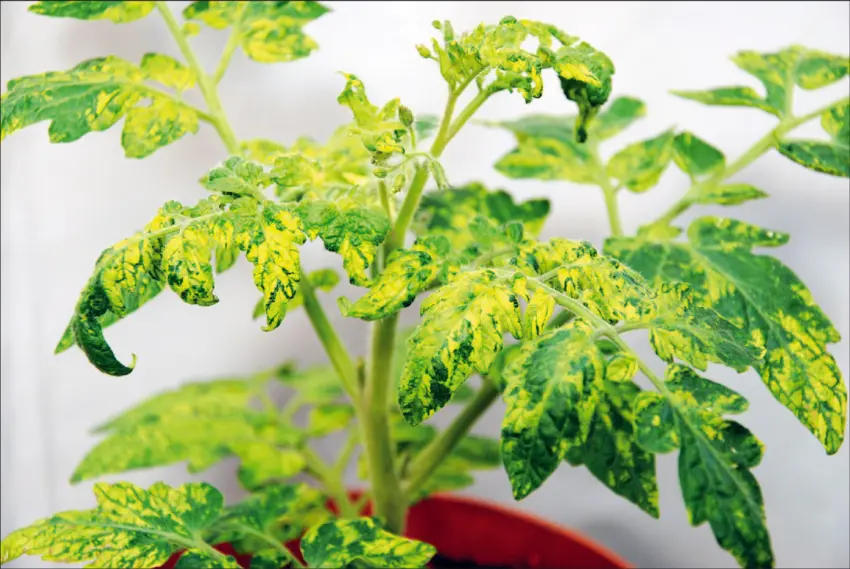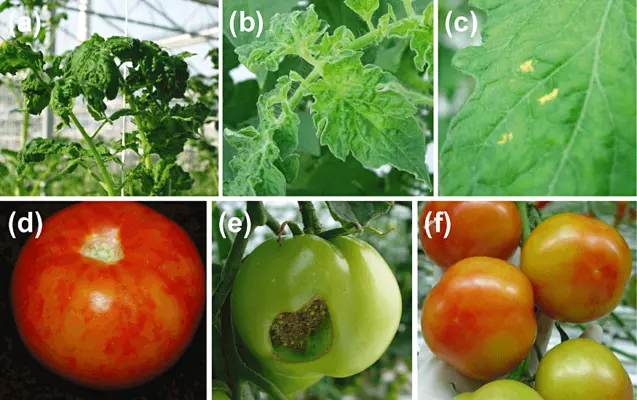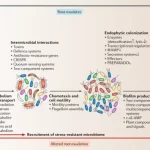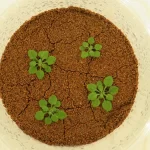Pepino Mosaic Virus (PepMV)
Introduction
Pepino Mosaic Virus (PepMV) is a highly infectious pathogen that primarily affects solanaceous plants, including tomatoes, potatoes, and eggplants [1][2][3]. It was first detected on pepino plants in Peru in 1974 and has since spread to several countries, causing significant problems in the cultivation of greenhouse tomatoes [1][3]. The virus is known for its rapid evolution, with four distinct genotypes identified: the original Peruvian genotype (LP), the European (tomato) genotype (EU), the American genotype US1, and the Chilean genotype CH2 [1].

The economic impact of PepMV is substantial. It poses a significant risk to the European tomato industry, with the potential for severe crop damage and adverse effects on the sustainability of European horticulture[4]. The virus is also a concern in North America, where it was first reported in greenhouse tomatoes in 2003 [3] [5].
|
Hosts |
Susceptibility |
|
Tomato (Solanum lycopersicum) |
High |
|
Pepino (Solanum muricatum) |
High |
|
Potato (Solanum tuberosum) |
Moderate |
|
Eggplant (Solanum melongena) |
Moderate |
|
Tobacco |
Low |
|
Pepper (Capsicum annum) |
Low |
We provide great overviews of many agricultural microorganisms. Subscribe to stay updated!
Symptoms
PepMV symptoms can be diverse and vary depending on the strain of the virus, the age, vigour, and variety of the plant, and the growing conditions in greenhouses[1][3][6]. Symptoms typically appear 2-3 weeks after infection [3]. Early symptoms are noticeable on infected plants’ growing terminals (heads), which may display light-green, thin or needle-like leaves and stunted growth[3]. Other symptoms include leaf blistering or bubbling, leaf chlorosis and yellow angular leaf spots, leaf mosaic, and leaf or stem necrosis [1][6]. The most typical and economically devastating symptom is fruit marbling [1][6].
Common Symptoms
- Mosaic patterns on leaves
- Yellowing and discoloration
- Distorted leaf growth
- Reduced fruit size
- Reduced fruit quality with fruit marbling

Life Cycle and Infection Stages
PepMV is a nonenveloped virus with a monopartite, positive-sense, single-stranded RNA genome[1]. The virus is very efficiently transmitted mechanically, and a low seed transmission rate has been demonstrated[1]. It can also be transmitted through plant-to-plant contact, propagation, and contaminated tools, hands, and clothing[2]. Bumblebees used as pollinators are also known to spread the disease[1][2].
Growth Conditions for
PepMV is a persistent virus that can survive and remain infectious for several weeks in plant debris and contaminated surfaces[7]. It is highly infectious and readily transmittable, with symptoms often expressed during fall and winter when temperatures and light levels are minimal[3].
Methods of Prevention and Control
Prevention of infection through strict hygiene measures is currently the primary strategy for controlling PepMV in tomato production[1][8]. This includes cleanliness at all crop production stages and avoiding using virus-contaminated tools, clothes, and surfaces[7][2]. Check this page for control measures: https://www.ontario.ca/page/management-pepino-mosaic-virus-greenhouse-tomatoes
Conclusion
PepMV is a significant threat to greenhouse tomato production, with potential for substantial economic impact. Strict hygiene measures and close monitoring of crops are crucial for controlling the spread of this virus. As our understanding of PepMV continues to grow, so will our ability to develop effective strategies for its management.
Disclaimer
The information we present in Pathogen Profile is based on collating published peer-reviewed scientific literature, and sources we think are reliable. This is by no means an exhaustive review of pathogens. Pathogen Profile gives a small glimpse of what is known about pathogens. We encourage growers to do more research on the pathogens concerning their crops and hydroponic systems. We are not plant pathologists; thus, the information presented in the Pathogen Profile should not be used as professional advice to treat pathogens or operate your system.
Banner image from EPPO Global Database:https://gd.eppo.int/taxon/PEPMV0/photos https://www.invasive.org/browse/detail.cfm?imgnum=5507942&
References
[1] Hanssen, I. M., & Thomma, B. P. (2010). Pepino mosaic virus: a successful pathogen that rapidly evolved from emerging to endemic in tomato crops. Molecular plant pathology, 11(2), 179–189. https://doi.org/10.1111/j.1364-3703.2009.00600.x
[2] Ministry for Primary Industries. (2023). Pepino mosaic virus (PepMV) in Auckland. NZ Government. https://www.mpi.govt.nz/biosecurity/exotic-pests-and-diseases-in-new-zealand/pests-and-diseases-under-response/pepino-mosaic-virus-pepmv-in-auckland/
[3] Ministry of Agriculture, Food and Fisheries. (2021, March). Pepino Mosaic Virus in Greenhouse Tomatoes. Government of British Columbia. https://www2.gov.bc.ca/assets/gov/farming-natural-resources-and-industry/agriculture-and-seafood/animal-and-crops/plant-health/phu-pepinomosaicvirus-greenhousetomatoesss.pdf
[4] European Commission. (2023). Pepino mosaic virus: epidemiology. economic impact and pest risk analysis | PEPEIRA Project | Fact Sheet | FP6. CORDIS | European Commission. https://cordis.europa.eu/project/id/44189/it
[5] Ling, K.-S., Li, R., & Bledsoe, M. (2013). Pepino mosaic virus genotype shift in North America and development of a loop-mediated isothermal amplification for rapid genotype identification. Virology Journal, 10, 117. https://doi.org/10.1186/1743-422X-10-117
[6] CABI. (2021). Pepino mosaic virus. CABI Compendium. https://doi.org/10.1079/cabicompendium.43661
[7] European and Mediterranean Plant Protection Organization (EPPO). (2023). Pepino mosaic virus. EPPO Datasheet. ttps://gd.eppo.int/taxon/PEPMV0/download/datasheet_pdf
[8] Ontario Ministry of Agriculture, Food and Rural Affairs. (2023). Management of Pepino Mosaic Virus in Greenhouse Tomatoes. https://www.ontario.ca/page/management-pepino-mosaic-virus-greenhouse-tomatoes
[9] Spence, N. J., Basham, J., Mumford, R. A., Hayman, G., Edmondson, R., & Jones, D. R. (2006). Effect of Pepino mosaic virus on the yield and quality of glasshouse-grown tomatoes in the UK. British Society for Plant Pathology. https://doi.org/10.1111/j.1365-3059.2006.01406.x
![]()
David Santos is the COO/CMO of Healthy Hydroponics InnoTech





